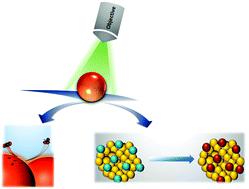当前位置:
X-MOL 学术
›
Chem. Soc. Rev.
›
论文详情
Our official English website, www.x-mol.net, welcomes your feedback! (Note: you will need to create a separate account there.)
Nanoscale optical imaging in chemistry.
Chemical Society Reviews ( IF 46.2 ) Pub Date : 2020-07-23 , DOI: 10.1039/d0cs00338g Andrew J Wilson 1 , Dinumol Devasia 1 , Prashant K Jain 2
Chemical Society Reviews ( IF 46.2 ) Pub Date : 2020-07-23 , DOI: 10.1039/d0cs00338g Andrew J Wilson 1 , Dinumol Devasia 1 , Prashant K Jain 2
Affiliation

|
Single-molecule-level measurements are bringing about a revolution in our understanding of chemical and biochemical processes. Conventional measurements are performed on large ensembles of molecules. Such ensemble-averaged measurements mask molecular-level dynamics and static and dynamic fluctuations in reactivity, which are vital to a holistic understanding of chemical reactions. Watching reactions on the single-molecule level provides access to this otherwise hidden information. Sub-diffraction-limited spatial resolution fluorescence imaging methods, which have been successful in the field of biophysics, have been applied to study chemical processes on single-nanoparticle and single-molecule levels, bringing us new mechanistic insights into physiochemical processes. However, the scope of chemical processes that can be studied using fluorescence imaging is considerably limited; the chemical reaction has to be designed such that it involves fluorophores or fluorogenic probes. In this article, we review optical imaging modalities alternative to fluorescence imaging, which expand greatly the range of chemical processes that can be probed with nanoscale or even single-molecule resolution. First, we show that the luminosity, wavelength, and intermittency of solid-state photoluminescence (PL) can be used to probe chemical transformations on the single-nanoparticle-level. Next, we highlight case studies where localized surface plasmon resonance (LSPR) scattering is used for tracking solid-state, interfacial, and near-field-driven chemical reactions occurring in individual nanoscale locations. Third, we explore the utility of surface- and tip-enhanced Raman scattering to monitor individual bond-dissociation and bond-formation events occurring locally in chemical reactions on surfaces. Each example has yielded some new understanding about molecular mechanisms or location-to-location heterogeneity in chemical activity. The review finishes with new and complementary tools that are expected to further enhance the scope of knowledge attainable through nanometer-scale resolution chemical imaging.
中文翻译:

化学中的纳米光学成像。
单分子水平的测量正在为我们对化学和生化过程的理解带来一场革命。常规测量是对大分子团进行的。这种整体平均测量掩盖了分子级动力学以及反应性的静态和动态波动,这对于全面了解化学反应至关重要。在单分子水平上观察反应可访问此原本隐藏的信息。在生物物理学领域中成功的亚衍射极限空间分辨率荧光成像方法已被用于研究单纳米和单分子水平的化学过程,从而为我们提供了有关物理化学过程的新机制。然而,可以使用荧光成像研究的化学过程的范围受到很大限制;必须对化学反应进行设计,使其涉及荧光团或荧光探针。在本文中,我们回顾了替代荧光成像的光学成像方法,它极大地扩展了可以用纳米级甚至单分子分辨率探测的化学过程的范围。首先,我们表明固态光致发光(PL)的光度,波长和间歇性可用于探测单纳米粒子级的化学转化。接下来,我们重点介绍案例研究,其中使用局部表面等离振子共振(LSPR)散射来跟踪在单个纳米级位置发生的固态,界面和近场驱动的化学反应。第三,我们探索了表面增强和尖端增强拉曼散射的效用,以监测表面化学反应中局部发生的单个键解离和键形成事件。每个例子都对化学活性的分子机制或位置间异质性有了新的认识。审查以新的补充工具结束,这些工具有望进一步扩大通过纳米级分辨率化学成像获得的知识的范围。
更新日期:2020-08-17
中文翻译:

化学中的纳米光学成像。
单分子水平的测量正在为我们对化学和生化过程的理解带来一场革命。常规测量是对大分子团进行的。这种整体平均测量掩盖了分子级动力学以及反应性的静态和动态波动,这对于全面了解化学反应至关重要。在单分子水平上观察反应可访问此原本隐藏的信息。在生物物理学领域中成功的亚衍射极限空间分辨率荧光成像方法已被用于研究单纳米和单分子水平的化学过程,从而为我们提供了有关物理化学过程的新机制。然而,可以使用荧光成像研究的化学过程的范围受到很大限制;必须对化学反应进行设计,使其涉及荧光团或荧光探针。在本文中,我们回顾了替代荧光成像的光学成像方法,它极大地扩展了可以用纳米级甚至单分子分辨率探测的化学过程的范围。首先,我们表明固态光致发光(PL)的光度,波长和间歇性可用于探测单纳米粒子级的化学转化。接下来,我们重点介绍案例研究,其中使用局部表面等离振子共振(LSPR)散射来跟踪在单个纳米级位置发生的固态,界面和近场驱动的化学反应。第三,我们探索了表面增强和尖端增强拉曼散射的效用,以监测表面化学反应中局部发生的单个键解离和键形成事件。每个例子都对化学活性的分子机制或位置间异质性有了新的认识。审查以新的补充工具结束,这些工具有望进一步扩大通过纳米级分辨率化学成像获得的知识的范围。


























 京公网安备 11010802027423号
京公网安备 11010802027423号